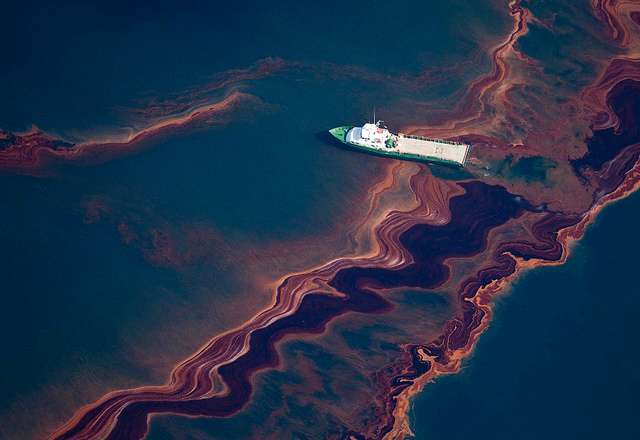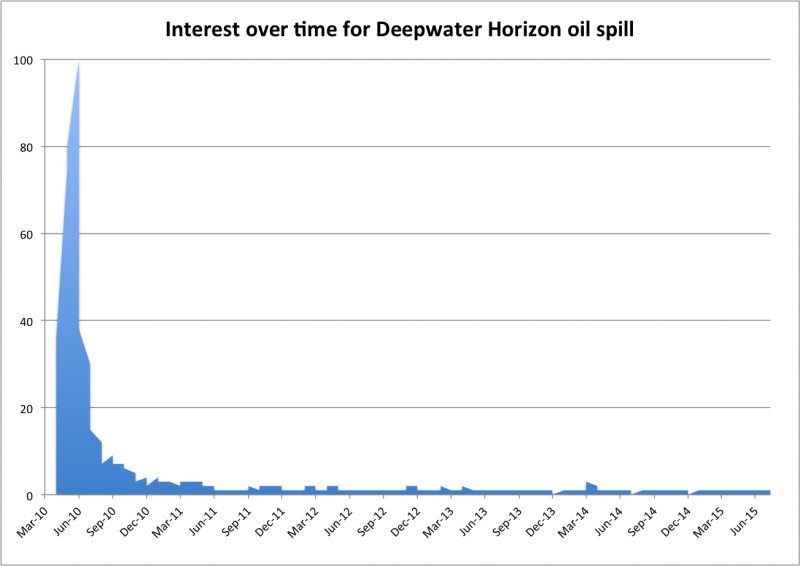An aerial view of the oil leaked from Deepwater Horizon, taken May 6, 2010. Credit: The Boston Globe.
June 8th marked another World Ocean's Day that has come and gone with presidential proclamations and local advocacy events. But the fanfare about the ocean doesn't seem to last. It's been five years since the Deepwater Horizon oil spill in the Gulf of Mexico and as scientific research continues to unfurl more details about the impacts of the spill, the public pays less attention as time moves on. Yet many questions still go unanswered. Where did all the oil go? How is it impacting the environment? What does this mean for future oil spill response?
Interest in the worst oil spill disaster in U.S. history has diminished as measured by the number of web searches performed over the past five years (See Figure 1).
Yet research is still unveiling interesting new findings about the impacts of the spill, and the legal process to determine how much BP will pay continues to play out in the courts.
4.9 million
This is how many barrels of oil spilled into the ocean during the Deepwater Horizon disaster in the summer of 2010. For comparison, this is more than seven times the amount of oil that is found annually in the Gulf of Mexico from natural seepage and other activities, like transportation.
As the oil spill was happening, researchers and other experts struggled to put an exact number on the amount of oil flowing out of the wellhead. Further complicating matters was the question of where the oil was going and where would it end up. Tourism to the Gulf region was impacted as nervous travelers cancelled their trips, which would ultimately have a lingering impact on the local economy for years after the spill.
Web search interest in “Deepwater Horizon oil spill” over time, as measured by Google Trends. Data from Google 2015.
Nonetheless, scientists today are making strides on some of those issues. In a recent PLOS ONE article, researchers from the University of South Florida found elevated hydrocarbon concentrations in the DeSoto Canyon—a 1500 m deep trench located in the Gulf of Mexico northeast of the spill site—in sediment samples taken from December 2010 to February 2011. This deep-sea environment is home to a unique ecosystem, but impacts from the oil spill on the corals and other organisms have been difficult to study. Therefore, finding elevated above normal amounts of hydrocarbons in this deep-sea region sheds some light on where some of the oil ended up and what this potentially means for the ecosystem.
Modeling where the oil went is a complicated process due to multiple modes of mixing and transport from currents, eddies, and three-dimensional circulation patterns. The researchers identified a couple of possible pathways of transmission for hydrocarbons to be transported from the well blowout site to the DeSoto Canyon. One is the interaction of the oil with microbes and particulates that bind to the oil and carry it to the sea floor as they sink, commonly referred to at "marine snow". The other pathway of hydrocarbons into the canyon is through direct contact between the oil plume spilling out of the wellhead, and remaining below the surface, and the sediments on the trench slope.
8,743
The number of foraminifera species in the modern record, with the majority of them found on the bottom of the sea floor. Forams, short for foraminifera, are an essential part of the marine food web and can serve as indicators of coral health and other environmental conditions. Many forams consist of calcium carbonate shells, which is similar to the structure of coral reefs. How forams react to changing ocean chemistry can be a marker for other species. Forams are also sensitive to hydrocarbons and other toxins.
Another recent study, conducted by many of the same researchers and released in March 2015, examined how forams were affected by the oil spill. They found that the density of forams on the deep-sea floor of the Gulf of Mexico (1000-1200 m) decreased by 80-93%, at two sample sites taken in December 2010. Another set of samples taken in February 2011 showed that forams closest to the wellhead may have begun to recover, however the site located further away showed a decrease in the foram populations that almost reached zero. The researchers encouraged subsequent sampling of forams to determine if recovery continued or occurred at either of the sites.
The eastern region of the Gulf of Mexico, and the deepest parts of the sea floor, were not well mapped before the disaster, but are considered hot spots of abundance in diversity. As oil spilled into the ocean for five months, researchers scrambled to determine baseline estimates for the ecosystem, including sediment cores to look at pre-oil spill bottom habitat. They also used remotely operated vehicles to compare sites that were contaminated with oil to sites that were not. Located in the deep darkness of the DeSoto Canyon in the Gulf of Mexico are corals and invertebrates like the brittlestar. These unique ecosystems serve as feeding grounds, nurseries, and homes for commercially viable fisheries, so understanding how they are affected by the oil spill will help to determine how recovery funds get distributed.
13.7 billion
This is the amount of money that BP is facing in penalties for spill-related violations of the Clean Water Act. 80 percent of these penalties will go to a trust fund to support research, restoration, and recovery efforts in the region, as directed by the RESTORE Act, passed by Congress in 2012.
This large sum of money directed towards the Gulf region will fund research for many years in the future. And although public attention may not be focused on the aftermath of the Deepwater Horizon oil spill, scientists are gaining a little bit more understanding every day to deal with the decades long process of recovery.
More information: McNutt, M.K., et al., 2012. "Applications of science and engineering to quantify and control the Deepwater Horizon oil spill," Proc. Nat. Acad. Sci., DOI: 10.1073/pnas.1214389109
Paris, C.B. et al., 2012. "Evolution of the Macondo Well Blowout: Simulating the Effects of the Circulation and Synthetic Dispersants on the Subsea Oil Transport," Environ. Sci. Technol., DOI: 10.1021/es303197h
Romero, I.C., et al., 2015. "Hydrocarbons in Deep-Sea Sediments following the 2010 Deepwater Horizon Blowout in the Northeast Gulf of Mexico," PLOS ONE, DOI: 10.1371/journal.pone.0128371
Schwing, P.T. et al., 2015. "A Decline in Benthic Foraminifera following the Deepwater Horizon Event in the Northeastern Gulf of Mexico," PLOS ONE, DOI: 10.1371/journal.pone.0120565
Journal information: PLoS ONE
Provided by Public Library of Science






















